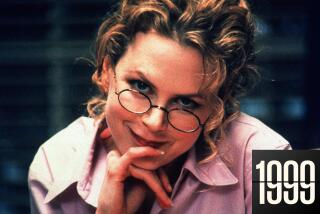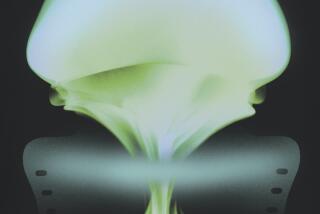‘Strangelove,’ ‘Sunday’ Fine Releases--but . . .
- Share via
Two signature British films of the early ‘60s and ‘70s reveal how well crisp laser transfers serve both classic black-and-white and color films. But while the Criterion Collection’s recent release of Stanley Kubrick’s “Dr. Strangelove or: How I Learned to Stop Worrying and Love the Bomb” (two discs, 93 minutes, standard play, 1964, $100) and Criterion’s earlier release of John Schlesinger’s “Sunday Bloody Sunday” (110 minutes, extended play, 1971, $50) offer the finest in technology, they ultimately disappoint as lasers because each lacks what would serve the film best: the director’s view of the film on a second analog audio track.
Nonetheless, each holds up well as models of storytelling, the director’s art and concerns that consumed us just a couple of decades ago, and still reverberate today.
Oddly enough it is Kubrick’s black-and-white “Dr. Strangelove” that is simultaneously the most fascinating and the most disappointing in the laser format. It is a meticulous effort, boasting a “new digital film-to-tape transfer” devised with a 35-millimeter duplicate negative and 35mm three-track magnetic master, and supervised by Kubrick.
The technical data matters less than the result: It offers the film’s outrageous black comedy of the Cold War years in all its horrendous splendor, from the tripartite performance of Peter Sellers as Group Capt. Lionel Mandrake, President Merkin Muffley and Dr. Strangelove himself to George C. Scott as Gen. Buck Turgidson and Sterling Hayden as the mad general, Jack D. Ripper. No one is better served, though, than Slim Pickens as Maj. T.J. King Kong, who rides The Bomb to eternity.
The screenplay by Kubrick and Peter George, on which Terry Southern also collaborated, comes through louder and more clearly than ever. Yet with all the supplementary material, including the original theatrical trailer, a draft of an early screenplay with an alternate opening and archival material documenting the nuclear fear that haunted many lives, we come up short without a Kubrick narrative filling in essential behind-the-scenes details on his motives and decisions.
Like the 1982 film “The Atomic Cafe,” a supplementary short called “Duck and Cover” and a ’64 music video called “My Teenage Fallout Queen,” provide a time-capsule glimpse into the tensions of the time and the chilling fears that we lived, and occasionally laughed at.
Both Kubrick’s dire morality tale of a Cold War gone haywire and Schlesinger’s morality tale of homosexual/heterosexual love ultimately turn on communications and how their failure can spell doom on catastrophic international and personal levels.
“Sunday Bloody Sunday,” featuring Glenda Jackson and Peter Finch in sterling performances, is offered with no supplementary materials. True, there are chapter stops by which you can readily access scenes, but with no additional materials whatsoever, especially no analogue track with Schlesinger or even Jackson contributing their invaluable insights and recollections, this becomes a disappointing reissue. Granted, we do get an important film, but none of the other amenities to which laser buyers have become accustomed.
More to Read
Only good movies
Get the Indie Focus newsletter, Mark Olsen's weekly guide to the world of cinema.
You may occasionally receive promotional content from the Los Angeles Times.










